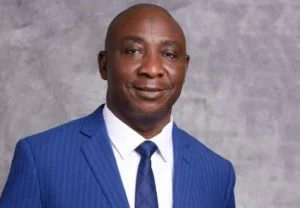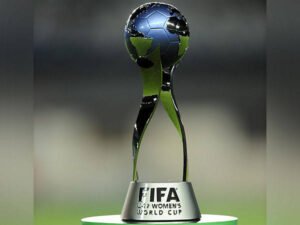FIFA should consider playing 2026 World Cup final at 9 a.m —- Expert

London, June 30, 2025 (BBCSports/CrestNewsOnline) Extreme weather during the ongoing FIFA Club World Cup in the United States (U.S) this summer means FIFA should think about playing the 2026 men’s World Cup final match at 9 a.m next year, according to an expert.
Professor Mike Tipton of Portsmouth University, a leading specialist on the effect of extreme temperature on the human body, recently spoke on how football’s governing body should handle a heatwave at next year’s tournament.
Like many, Tipton has been struck by the brutal conditions that players have been exposed to in some matches at the Club World Cup in the U.S.
It is that which have underlined the potential threat facing FIFA’s 2026 showpiece when it returns to the same country at the same time of year.
Last week saw the summer’s first major heatwave descend on eastern North America, with dozens of people hospitalised for heat-related illnesses.
In New York on 24 June, for instance, the temperature rocketed to 39C —- a record for June.
The MetLife Stadium just outside the city is due to stage eight matches at the FIFA World Cup, including the final itself.
Like most of the other venues across the US, Canada and Mexico, it has no roof and there is limited shade for those inside.
Kick-off times for all fixtures will only be revealed after December’s draw, but insiders said they expect matches in the eastern time zone to start at noon, 15:00, 18:00 and 21:00 local time.
This will be what the all-important European audiences and the interests of broadcasters, advertisers and sponsors will be having in mind
Tipton —— who works with Team GB athletes including triathlete Jonny Brownlee since his collapse from heat exhaustion in Mexico in 2016 —– argues that if there is a repeat of the conditions seen over the past 10 days, rescheduling to a morning slot would be the best and safest solution, even for the World Cup final.
“I’d move it to an air-conditioned stadium with a roof, and preferably to a cooler time of the year,” he said.
“But we’re already stuck with this, so the only thing you can do is go to a cooler time of day.
“From a thermal-physiological perspective, for both health and performance reasons, I’d be looking to start games as early as possible —- but I understand the logistical caveats,” he added, acknowledging the task of getting tens of thousands of fans inside a stadium so early in the day.
“The health risks are not purely to the players, it’s also the officials and spectators, many of whom are much, much less fit.
“If you continue in conditions when all the rational scientific data says ‘stop’, organisers are taking on a fair amount of responsibility. What would probably happen is the game would be changed radically.
“FIFA should be thinking about where, when and how they play such games. It’s not beyond the realms that matches have to go to quarters rather than halves.”
While such suggestions may seem far-fetched to some, a more flexible approach is something global players’ union Fifpro is now calling for after what it calls the “wake-up call” of the Club World Cup.
At a news conference on Monday, its medical director Dr Vincent Gouttebarge said extended half-time breaks of 20 minutes in extreme heat to keep players’ core temperatures within their normal range should be considered.
Alexander Bielefeld, FIFPRO’s director of policy, claimed the weather was of “increasing concern”, and that while postponing matches for heat was “slightly trickier” than in a domestic league “we clearly believe that from a health and safety perspective this is something that must take priority over commercial interests.”
FIFA guidelines currently rely on the Wet Bulb Globe Temperature (WBGT), a measure of heat stress combining temperature and humidity.
If the WBGT exceeds 32C, short ‘cooling breaks’ are mandatory in both halves of a match.
In contrast, FIFPRO believes breaks should be introduced once the WBGT goes above 28C, and that if it exceeds 32C matches should be delayed.
On this basis, so far at the Club World Cup both PSG v Atletico Madrid in Pasadena and Chelsea v ES Tunis in Philadelphia “should have been postponed to a better place in the day and, if not available (another slot), then rescheduled”.
“We are partially happy, because FIFA have been quite responsive once the tournament was underway [and] have actually modified how they’ve been dealing with heat during matches, based on our input,” said FIFPRO general secretary Alex Phillips.
“Obviously it would have been better if that had happened in advance, but they’ve put in place measures such as additional water and towels around the pitch.
“There’s a question at some point [over] what the industry sees as a precautionary threshold to players, but also to spectators, to potentially delay kick-off later on.
“You can apply so many pragmatic measures, such as shading, hydration, cooling, etc. At some point, that probably won’t be enough. And that’s a discussion which we need to have, even though this is a difficult conversation based on commercial interests.”
Earlier this year, researchers from Queen’s University Belfast warned the temperatures at 14 of the 16 stadiums being used for the 2026 World Cup could exceed potentially-dangerous levels.
Miami and Monterrey pose the greatest risk as they do not have air-conditioned stadiums.
While Dallas and Houston do have cooling systems, it said there was still a risk to spectators if games were played in the afternoon.
Significantly, the report also suggested afternoon games be avoided in New York, along with Kansas City, Boston and Philadelphia.
FIFPRO says any afternoon kick-offs at six venues —- Kansas City, Miami, Monterrey, Houston, Dallas and Atlanta —- carry an “extremely high-risk” of a “heat-stress injury”.
Only two —- San Francisco and Vancouver —- are rated “low-risk”.
When asked if FIFPRO will make recommendations to FIFA before the World Cup when it comes to kick-off times at certain venues, Phillips said: “We have absolutely no power to force them to, we can only use informal pressure.
“We will use common sense arguments. We can use the MLS [Major League Soccer] protocols. They don’t play matches at midday in Florida, for example, and haven’t done for a number of years. So those kind of arguments are strong.”
However, with more matches next year (104) than at any previous World Cup, FIFA may feel its ability to adapt scheduling and postpone matches is limited.
The dangers of playing in high temperatures in the U.S have been known for some time.
In 2017, England forward Rachel Daly was treated for heat exhaustion in hospital after collapsing during a match in Houston, while playing in the National Women’s Soccer League.
And during last year’s COPA America, Guatemalan assistant referee Humberto Panjoj had to be withdrawn from a game in Kansas City after collapsing on the field.
But the heat seems to have been a constant theme throughout the Club World Cup.
Last week Chelsea manager Enzo Maresca said it was “impossible” to organise normal training sessions amid a severe “code red” warning in Philadelphia, where 45% humidity made 37C feel a roasting 45C.
Meanwhile, Borussia Dortmund’s substitutes watched the first half of their match against Mamelodi Sundowns in Cincinnati from the dressing room, with manager Niko Kovac likening conditions to “a sauna”.
Someone who has also experienced such conditions is former Republic of Ireland goalkeeper Packie Bonner, who in 1994 played in a match against Mexico in Orlando that is still remembered for the intense 41C heat his team had to endure.
“It was unbelievable,” he told Santa “Kick-off was at noon and we couldn’t handle it at all. We were a high-pressing team and we couldn’t do that. But also your decision-making was affected. Your brain goes into a fog.”
Bonner believes conditions next year will be “treacherous from a heat point of view”.
But he added that, unlike back then when FIFA only allowed water to be given to players on the touchline, they are now allowed to drink on the pitch.
“We didn’t have all the things that they have now. Players now are a little bit more used to it, and as long as they’re hydrated it shouldn’t be a problem,” he said.
(www.crestnewsonline.ng)




